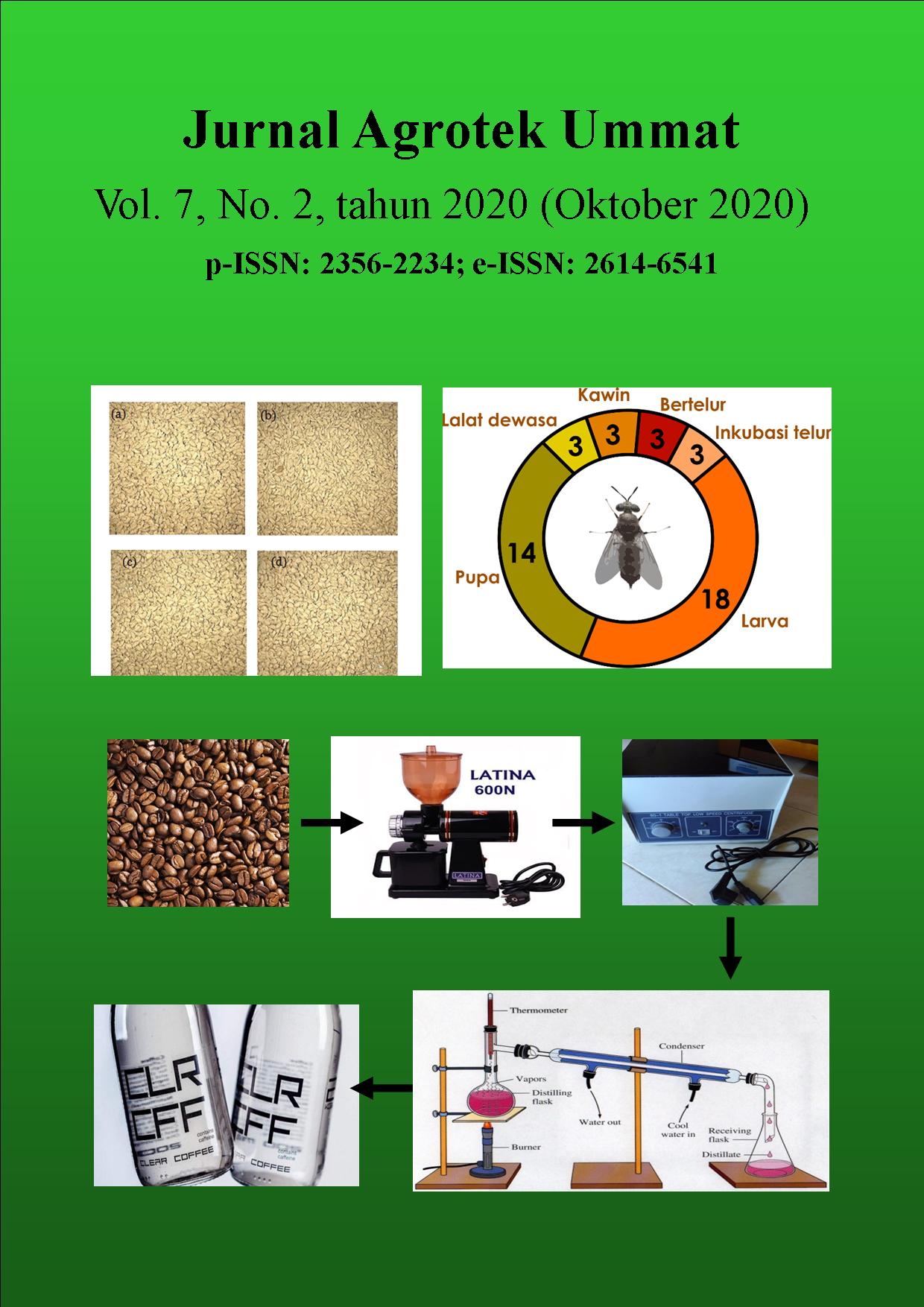PENGARUH PENAMBAHAN EKSTRAK BELIMBING WULUH (Averrhoa bilimbi L.) TERHADAP KARAKTERISTIK FISIK, MASA SIMPAN, DAN ORGANOLEPTIK PERMEN JELLY DAUN KERSEN
DOI:
https://doi.org/10.31764/jau.v7i2.2795Keywords:
Starfruit, Cherry leaf, Jelly candy, Organoleptic, Shelf lifeAbstract
Jelly is a candy made from components of water or fruit juice, flavor, sugar, and gelling ingredients. Apart from fruit juice, jelly candy can be made from the basic ingredients of leaf extracts. One of the leaves that can be used is Muntingia calabura L. leaves. The existing jelly candies generally do not use natural ingredients as colorings and flavors. Fruits that can be used as natural ingredients in making jelly candy are Averrhoa bilimbi L. This study aims to determine the effect of adding starfruit extract to the physical quality, shelf life, and organoleptic of Muntingia calabura L. leaves jelly candy. This study used a Completely Randomized Design (CRD) with 1 factor, namely the concentration of Averrhoa bilimbi L extract (0%, 5%, 10%, 15%, and 20%). The results of this study indicate that the addition of Averrhoa bilimbi L extract does not significantly affect the physical quality (color) of Muntingia calabura L. leaves jelly candy. In the shelf life test, the addition of Averrhoa bilimbi L extract gave a real effect, where the best treatment was the concentration of Averrhoa bilimbi L. extract 15% and 20%. In the organoleptic test, the addition of Averrhoa bilimbi L extract did not significantly affect the level of preference (hedonic) and the level of acceptance (scoring) of the texture, but it did affect the level of panelist acceptance of the color, aroma, and taste of Muntingia calabura L. leaves jelly candy. The best treatment of panelist acceptance level for color is at a concentration of 0% producing jelly candy with a yellowish-brown color and the best aroma and taste of jelly candy at a concentration of 20% producing jelly Averrhoa bilimbi L -flavored jelly candy with a slightly bitter sweet taste with a slightly bitter sweetness.
References
Ahmad, L., Une, S. and Bait, Y. (2019) ‘Karakteristik Komponen Gizi, Antioksidan, dan Respon Organoleptik Bubur Jagung Tradisional Gorontalo dengan Ekstrak Daun Kersen (Muntingia calabura L.)’, agriTECH. doi: 10.22146/agritech.28670.
Amelia, F. R. (2015) ‘Penentuan Jenis Tanin dan Penetapan Kadar Tanin dari Buah Bungur Muda (Lagerstroemia speciosa Pers.) Secara Spektofotometri dan Paranganometri’, Jurnal Ilmiah Mahasiswa Universitas Surabaya.
Andriani, W. O. R. A., Ansharullah and Asyik, N. (2018) ‘KARATERISTIK ORGANOLEPTIK DAN NILAI GIZI SNACK BAR BERBASIS TEPUNG BERAS MERAH (Oryza nivara) DAN TEPUNG JAGUNG (Zea mays L.) SEBAGAI MAKANAN SELINGAN TINGGI SERAT’, Jurnal Sains dan Teknologi Pangan (JSTP).
Aprilliani, N. and Ginting Suka, E. (2017) Efektivitas Ekstrak Daun Belimbing Wuluh (Averrhoa Bilimbi L.) Sebagai Inhibitor Pada Baja St37 Dalam Medium Korosif NaCl 3%, Jurnal Teori dan Aplikasi Fisika. doi: 10.23960/JTAF.V5I2.1812.
Buhian, W. P. C. et al. (2016) ‘Bioactive metabolite profiles and antimicrobial activity of ethanolic extracts from Muntingia calabura L. leaves and stems’, Asian Pacific Journal of Tropical Biomedicine. doi: 10.1016/j.apjtb.2016.06.006.
CANDRA, S., DK, K. and Widodo, Y. (2012) ‘PENGARUH PEMBERIAN EKSTRAK BUAH BELIMBING WULUH (Averrhoa blimbi L.) TERHADAP PENURUNAN KADAR GLUKOSA DARAH TIKUS WISTAR YANG DIINDUKSI ALOKSAN’, Jurnal Kedokteran Diponegoro.
Fitri, dkk. (2017) ‘Konsentrasi Gula dan Sari Buah Terhadap Kualitas Sirup Belimbing Wuluh (Averrhoa bilimbi L.)’, JOM Faperta UR.
Mahar Maligan, J., Dian Pratiwi, D. and Dewanti Widyaningsih, T. (2019) ‘Studi Preferensi Konsumen terhadap Nasi Putih dan Nasi Jagung Putih pada Pekerja Wanita di Kantor Pemerintah Kota Malang’, Indonesian Journal of Human Nutrition. doi: 10.21776/ub.ijhn.2019.006.01.5.
Marfungah, N. et al. (2019) ‘PENGARUH PENAMBAHAN BUBUK KAYU MANIS (Cinnamon burmanii) TERHADAP KARAKTERISTIK KIMIA DAN ORGANOLEPTIK PERMEN JELLY DAUN SALAM (Syzygium polyanthum)’, J. Sains dan Teknologi Pangan.
MEILGAARD MORTEN, C., VANCE, C. G. and THOMAS, C. B. (2016) Sensory Evaluation Techniques fifth edition, CRC Press Taylor & Francis Group Boca Raton, FL - USA. doi: 10.1111/j.1471-0307.2007.00330.x.
Meutia, Y. R. et al. (2015) ‘Pengaruh Suhu dan Waktu Maserasi terhadap Komponen Volatil yang Terlibat pada Ekstraksi Andaliman ( Zanthoxylum acanthopodium DC )’, Journal of Agro-based Industry.
‘Peningkatan Nilai Tambah Daun Kersen (Muntingia Calabura L.) Menjadi Permen Jelly dan Teh Seduh’ (2019) Jurnal Abdimas.
Pino, J. A., Marbot, R. and Bello, A. (2004) ‘Volatile components of averrhoa bilimbi L. Fruit grown in Cuba’, Journal of Essential Oil Research. doi: 10.1080/10412905.2004.9698710.
Roikah, S. et al. (2016) ‘EKSTRAKSI DAN KARAKTERISASI PEKTIN DARI BELIMBING WULUH (Averrhoa bilimbi,L)’, Jurnal Bahan Alam Terbarukan. doi: 10.15294/jbat.v5i1.5432.
Sinurat, E. and Murniyati, M. (2014) ‘Pengaruh Waktu dan Suhu Pengeringan terhadap Kualitas Permen Jeli’, Jurnal Pascapanen dan Bioteknologi Kelautan dan Perikanan. doi: 10.15578/jpbkp.v9i2.106.
Tyas Eka, V. (2009) ‘UJI EFEKTIFITAS JUS BUAH KERSEN (Muntingia calabura L.) TERHADAP PENURUNAN KADAR GLUKOSA DARAH PADA TIKUS PUTIH (Rattus norvegicus)’, Biology.
Wahyuni, R. (2010) ‘Optimasi Pengolahan Kembang Gula Jelly Campuran Kulit Dan Daging Buah Naga Super’, OPTIMASI PENGOLAHAN KEMBANG GULA JELLY CAMPURAN KULIT DAN DAGING BUAH NAGA SUPER MERAH (Hylocereus costaricensis) DAN PRAKIRAAN BIAYA PRODUKSI Rekna.
Zakaria, Z. A. et al. (2011) ‘In vivo antiulcer activity of the aqueous extract of Bauhinia purpurea leaf’, Journal of Ethnopharmacology. doi: 10.1016/j.jep.2011.07.038.
Downloads
Published
Issue
Section
License
Authors who publish articles in Jurnal Agrotek Ummatagree to the following terms:- Authors retain copyright of the article and grant the journal right of first publication with the work simultaneously licensed under a CC-BY-SA or The Creative Commons Attribution–ShareAlike License.
- Authors are able to enter into separate, additional contractual arrangements for the non-exclusive distribution of the journal's published version of the work (e.g., post it to an institutional repository or publish it in a book), with an acknowledgment of its initial publication in this journal.
- Authors are permitted and encouraged to post their work online (e.g., in institutional repositories or on their website) prior to and during the submission process, as it can lead to productive exchanges, as well as earlier and greater citation of published work (See The Effect of Open Access).

